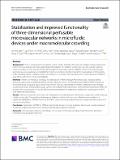| dc.contributor.author | Wan, Ho-Ying | |
| dc.contributor.author | Chen, Jack C. H. | |
| dc.contributor.author | Xiao, Qinru | |
| dc.contributor.author | Wong, Christy W. | |
| dc.contributor.author | Yang, Boguang | |
| dc.contributor.author | Cao, Benjamin | |
| dc.contributor.author | Tuan, Rocky S. | |
| dc.contributor.author | Nilsson, Susan K. | |
| dc.contributor.author | Ho, Yi-Ping | |
| dc.contributor.author | Raghunath, Michael | |
| dc.contributor.author | Kamm, Roger D. | |
| dc.contributor.author | Blocki, Anna | |
| dc.date.accessioned | 2023-04-25T18:41:14Z | |
| dc.date.available | 2023-04-25T18:41:14Z | |
| dc.date.issued | 2023-04-19 | |
| dc.identifier.uri | https://hdl.handle.net/1721.1/150569 | |
| dc.description.abstract | Abstract
Background
There is great interest to engineer in vitro models that allow the study of complex biological processes of the microvasculature with high spatiotemporal resolution. Microfluidic systems are currently used to engineer microvasculature in vitro, which consists of perfusable microvascular networks (MVNs). These are formed through spontaneous vasculogenesis and exhibit the closest resemblance to physiological microvasculature. Unfortunately, under standard culture conditions and in the absence of co-culture with auxiliary cells as well as protease inhibitors, pure MVNs suffer from a short-lived stability.
Methods
Herein, we introduce a strategy for stabilization of MVNs through macromolecular crowding (MMC) based on a previously established mixture of Ficoll macromolecules. The biophysical principle of MMC is based on macromolecules occupying space, thus increasing the effective concentration of other components and thereby accelerating various biological processes, such as extracellular matrix deposition. We thus hypothesized that MMC will promote the accumulation of vascular ECM (basement membrane) components and lead to a stabilization of MVN with improved functionality.
Results
MMC promoted the enrichment of cellular junctions and basement membrane components, while reducing cellular contractility. The resulting advantageous balance of adhesive forces over cellular tension resulted in a significant stabilization of MVNs over time, as well as improved vascular barrier function, closely resembling that of in vivo microvasculature.
Conclusion
Application of MMC to MVNs in microfluidic devices provides a reliable, flexible and versatile approach to stabilize engineered microvessels under simulated physiological conditions. | en_US |
| dc.publisher | BioMed Central | en_US |
| dc.relation.isversionof | https://doi.org/10.1186/s40824-023-00375-w | en_US |
| dc.rights | Creative Commons Attribution | en_US |
| dc.rights.uri | http://creativecommons.org/licenses/by/4.0/ | en_US |
| dc.source | BioMed Central | en_US |
| dc.title | Stabilization and improved functionality of three-dimensional perfusable microvascular networks in microfluidic devices under macromolecular crowding | en_US |
| dc.type | Article | en_US |
| dc.identifier.citation | Biomaterials Research. 2023 Apr 19;27(1):32 | en_US |
| dc.contributor.department | Massachusetts Institute of Technology. Department of Biology | |
| dc.contributor.department | Massachusetts Institute of Technology. Department of Mechanical Engineering | |
| dc.identifier.mitlicense | PUBLISHER_CC | |
| dc.eprint.version | Final published version | en_US |
| dc.type.uri | http://purl.org/eprint/type/JournalArticle | en_US |
| eprint.status | http://purl.org/eprint/status/PeerReviewed | en_US |
| dc.date.updated | 2023-04-23T03:06:46Z | |
| dc.language.rfc3066 | en | |
| dc.rights.holder | The Author(s) | |
| dspace.date.submission | 2023-04-23T03:06:46Z | |
| mit.license | PUBLISHER_CC | |
| mit.metadata.status | Authority Work and Publication Information Needed | en_US |
